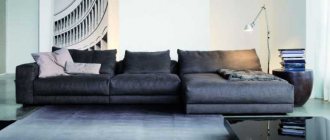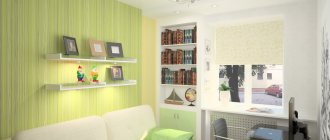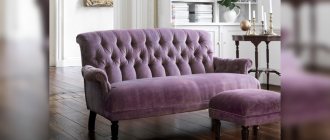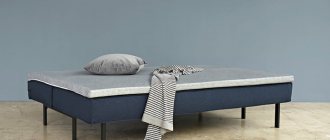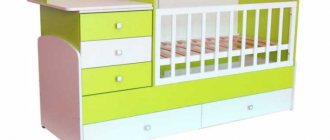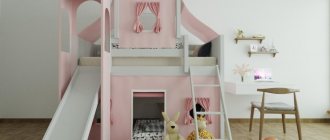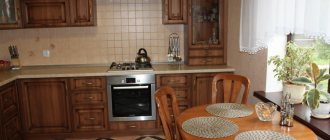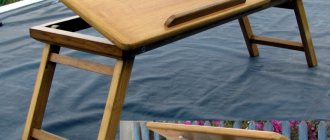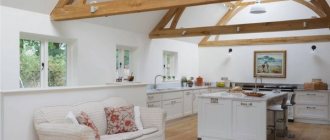The kitchen is a multifunctional room. Often, people not only cook here, but also gather the whole family or arrange friendly get-togethers - not all apartments have a living room and dining room. For this reason, apartment owners are faced with the task of making the kitchen as comfortable as possible.
Those who want to not only receive guests, but also leave them at home for the night, will love a kitchen corner with a sleeping area. What models of such furniture are there and how to choose the right option for your kitchen - read on.
Advantages and disadvantages of a sleeping area in the kitchen
A kitchen corner sofa with a sleeping place is an excellent option for people who like to receive guests, but do not have the opportunity to equip a separate room for this. The design does not take up much space, but allows you to accommodate several overnight guests with all amenities.
This type of furniture is a small sofa that can be converted into a small bed if necessary. Often such sets include chairs, drawers and a table.
Sleeping furniture has a number of advantages:
- extra bed for guests;
- the ability to accommodate more people than on chairs occupying the same area;
- the presence of drawers - additional storage space;
- L-shaped, thanks to which sofas can be easily placed in the corner of the kitchen;
- Unlike chairs, a soft sofa is more comfortable and creates a cozy atmosphere.
Many designers are abandoning kitchen corners in favor of sets with tables and chairs. This is due to the disadvantages of these designs:
- in the kitchen, soot and grease settle on the furniture—sofa upholstery, even made from the most practical material, will have to be cleaned frequently;
- a small sofa looks more bulky than chairs - in small kitchens such furniture will visually reduce the space;
- not all cheap kitchen corners look modern - such furniture is simply not suitable for some interior styles;
- if a large group is sitting on the sofa, in order for one person to leave the table, everyone else will have to get up;
- For a kitchen with a non-standard layout, choosing a corner sofa is not easy.
Size options
Before making a purchase, you need to evaluate the size of the kitchen corner. Furniture should fit harmoniously into the interior, and its daily use should be comfortable. In addition, it is necessary to determine how important certain additional components are. After all, every element that increases the functionality of a product is reflected in its cost.
Basic elements, styles and colors of kitchen furniture, arrangement methods
Standard
The greatest demand is for standard kitchen corners, the dimensions of which are ideal for arranging standard apartments. They are divided into 3 main categories:
- Minimum - with a length of 150 and a width of 110 cm.
- Maximum - 200 × 140 cm.
- Optimal - 160 × 110 cm.
The height of furniture with a backrest, as a rule, varies from 80 to 100 cm. The distance to the seat usually does not exceed 50 cm. The depth of the seat is no less important; it should be in the range from 45 to 70 cm.
In rectangular models, the table does not extend beyond the boundaries of both sections. If the set includes chairs, they increase the occupied space by approximately half a meter. To eliminate any problems during the installation and further operation of the furniture, it is advisable to draw up a drawing before purchasing. The purchased headset must exactly correspond to the calculated parameters.
Optimal
Maximum
Minimum
Modular
A modular kitchen corner is an excellent solution for extraordinary, modern interiors. Furniture of this type is assembled from several parts. The different parts are securely attached to each other during the assembly process. If you plan to regularly transform the corner, its components move tightly and, if necessary, are easily separated. Key advantages of modular kits:
- Quick assembly and disassembly that does not require professional skills.
- Possibility of using modules separately.
- Simple transformation of furniture.
Due to their characteristic features, such designs are successfully used when decorating small kitchens. After all, their sizes are not limited by any standards. They ideally complement the loft or hi-tech style, but do not fit with a classic interior.
Most modular kitchenettes are more expensive than solid models.
With sleeping place
Among the kitchen corners for a small kitchen, it is unlikely that you will be able to choose a model with a sleeping place. This product cannot be called compact, but unlike other analogues, it is the most functional option. When choosing a kit, you must take into account its unfolded dimensions. Minimum dimensions:
- For models with one bed - 180 × 60 cm.
- For sets that can accommodate 2 people - 180 × 120 cm.
Creating kitchen furniture with your own hands, work procedure, important nuances
Products with smaller widths are made to order only. When purchasing a kitchenette with a sleeping area, it is advisable to choose an easily transformable table and folding chairs. Otherwise, the unfolded furniture will take up the entire kitchen area, and there will be no free space left for other elements.
With storage system
Kitchen corners equipped with additional compartments for storing various things are in particular demand. They are very easy to use and have good capacity. As a rule, additional boxes are installed under the seats, so they do not affect the size of the entire structure. In some models they move forward, which is not very convenient in a small kitchen. Most often, access to the box is provided by lifting the soft part. In addition, the product can be equipped with shelves of various shapes and sizes, both inside and outside.
Varieties of sleeping corners
There are several types of sleeping corners for the kitchen. First of all, they differ in design:
- Whole. The sofa consists of 2 or 3 seats, fastened with corner joints. The shape of such a structure cannot be changed.
- Modular. The furniture is an ensemble of several unconnected seats that can be easily given any shape. They can even stand opposite each other, gathering into a sleeping place if necessary.
The shape of the corner with a sleeping place in the kitchen also varies:
- L-shaped. Parts of the sofa occupy 2 adjacent walls.
- U-shaped. The seats are immediately adjacent to 3 walls of the room.
- Parallel. In this case, two sofas stand opposite each other. If necessary, they are collected and become a sleeping place.
The corners also differ in size. The following are considered standard:
- corner height – 0.8-1 m;
- seat height – 0.4-0.5 m;
- width – 0.45-0.7 m;
- seat length – 1-1.4 for the smaller part, 1.5-2 for the larger part.
To order, manufacturers make wider, longer or narrower corners. At a furniture factory you can even provide your own sketch - however, this option cannot be called inexpensive.
The equipment of the kitchen corners also differs. The most common option is a sofa and a table (the latter is not necessarily included in the set). Many corner sofas in the kitchen have additional storage space. Sometimes this also includes chairs or poufs that match the color.
Folding mechanisms
Corner beds for the kitchen also differ in the mechanism by which the sofa turns into a sleeping place.
Here are three main options:
- Dolphin. This is the name of the system, which is converted into a bed thanks to a retractable soft block. This is a convenient but expensive design that takes up minimal space and in most cases is equipped with drawers.
- French corner. This type of furniture consists of three sections, which are stacked and hidden in the frame. To turn the sofa into a bed, just pull the special ropes. This option cannot be called convenient, and there is no storage space.
- Block design . To turn soft seats into a sleeping place, all poufs and sofas are assembled into a single unit. This option looks stylish, but the blocks may move apart during sleep.
Upholstery and frame material
Kitchen ensembles with a sleeping area are made from different materials. The list includes frame options:
- Tree. Such furniture looks expensive, noble and is environmentally friendly, durable and wear-resistant. Thanks to treatment with special means, it becomes resistant to moisture and temperature changes. Despite this, it is not recommended to place it near the battery. Kitchen corners are made of beech, oak, pine or birch. The main disadvantage of wood is its high cost.
- Chipboard and MDF. Inexpensive but less environmentally friendly materials. Externally, such frames look like wood. They are laminated or treated with special compounds that protect them from extreme conditions in the kitchen. This option is short-lived and quickly loses its attractive appearance.
- Steel. This frame is cheaper than wood and looks more modern. At the same time, it is considered the most durable and reliable.
When choosing a sofa, it is important to pay attention to the filling. Depending on their hardness, they are divided into the following classes:
- EL – high rigidity;
- HL – hard;
- E – normal stiffness;
- HR – high elasticity (the best option, does not deform for a long time);
- ER – soft;
- HS – very soft.
Most manufacturers use foam filling for kitchen corners. To make the sofa last longer and be more comfortable, springs are inserted into the frame. There are also more expensive models with coconut filling.
How easy it will be to care for the sofa depends on the upholstery material:
- Synthetics. These fabrics are inexpensive, easy to care for, and can even be machine washed. If a high-quality dye was used, the color will not become dull after numerous washes. The main disadvantage of this material is that it releases substances harmful to health when burned. Also, synthetic fabric is not pleasant to the touch for everyone.
- Cotton with synthetics. With numerous washes, the material loses color and becomes covered with pellets, but is more pleasant in terms of tactile sensations.
- Leather. The most expensive material for upholstering corners in the kitchen. It is easy to maintain and fireproof. To remove dirt, just wipe it with a damp cloth. This upholstery looks expensive and noble.
- Leatherette. High-quality leatherette looks no worse than genuine leather, but costs less. It is easy to care for. It is less durable than natural material.
Installation of a folding corner sofa in the kitchen
A folding sofa in the kitchen allows you not only to eat comfortably, but also to relax. It consists of a supporting (and, if there is a box, a lifting) structure, a bed, a backrest, armrests and a folding mechanism.
Layout mechanism
A corner convertible sofa is an excellent option for the kitchen; it easily solves the problem of lack of space. Depending on the type of mechanism used, the sofa can fold out in different directions.
The most common transformation mechanisms are “book”, “eurobook”, “dolphin” and “accordion”. They are quite simple and do not require much effort when unfolding. A kitchen corner folding sofa can be equipped with a “French folding bed” transformation mechanism, which can be folded out in several stages, but this mechanism is not designed for daily use.
Choosing a filler to make sitting comfortable
When buying a corner sofa, you need to make sure that it is soft and cozy enough. Fillers can be foam rubber, polyurethane foam and holofiber. Each material has advantages and disadvantages. Foam rubber is the most budget-friendly filler, but it also has the shortest service life. It wrinkles quite quickly, so the seats on such a sofa can quickly fall through.
The advantages of polyurethane foam include softness, strength, fire resistance and safety for the health of all family members. Its price is higher, so a product with such a filler will be more expensive.
Holofiber is not inferior in characteristics to polyurethane foam, and its main advantage is the ability to restore its shape after heavy loads.
Kitchen sofa upholstery
Leather and its substitutes, eco-leather and textiles are used to upholster the seats and backs of sofas. This furniture is intended for kitchens where there is a possibility of contamination. Therefore, it is better to give preference to those materials from which dirt and stains can be easily removed. Leather and its substitutes are easy to clean, but such upholstery has its drawback - it darkens over time and loses its attractive appearance.
Fabric upholstery is very diverse and brings home comfort and harmony to the interior. When choosing textiles, pay attention to its thickness - only durable fabric will last a long time without changing its characteristics.
Another option for protecting upholstery from possible contamination is sewing covers that can easily be washed in an automatic machine. This way you can change the color scheme of the dining space in the kitchen.
Selection rules
Before purchasing a kitchen corner, they draw up a design project for the room. This will allow you to determine the size of the furniture set and its design.
When choosing a corner for the kitchen, pay attention not only to its appearance, but also to other parameters. The list contains the main tips from designers:
- Dimensions. Before purchasing, take measurements of the area where the corner will be located. The size of the sofa is calculated in such a way that there is a free passage distance of at least 70 cm in the kitchen. It is also important to take into account the size of the part that will be folded out, turning the sofa into a bed.
- For a corner with a sleeping place, choose a table that can be easily moved. Some people attach the folding tabletop to the wall.
- In small kitchens, massive corners will clutter up the space . In this case, narrow models complemented by chairs or poufs are preferable. Sofas without a back look the most compact.
- When choosing a comfortable sleeping place, pay special attention to the filling. Hard or moderately hard options with springs in the design are more durable.
- For a non-standard layout, it is better to make custom-made furniture.
- Upholstery made of leather, synthetics or leatherette is considered more practical and durable . Natural fabrics are inappropriate in the kitchen.
- It is better not to use furniture made of chipboard. It releases toxic substances, especially when heated.
- There are right-hand and left-hand corners - when choosing such furniture, they think in advance where it will stand.
Furniture design
When choosing furniture for the kitchen, consider the style of the interior. Here are some tips for matching your kitchen corner with different kitchen designs:
- Scandinavian styles. Simple and laconic furniture without unnecessary decor will do. Sofas without a back are ideal. They look simple and modern.
- Industrial style . Kitchen corners made of leather or its artificial substitute will fit succinctly. Solid furniture will do.
- Classic interiors. Corners on curved legs, with textile or leather upholstery, will fit perfectly into the classics. Classic shapes are welcome.
- Romantic styles. Small sofas with textile upholstery and ruffles look good. Forged sofas are welcome.
- Modern interiors. Sofas of both simple and laconic and unusual shapes without unnecessary decor are suitable.
- Modern. Modular corners without a back look best.
Furniture color
The color of the furniture is chosen depending on the style of the interior and the size of the room . The list contains some basic tips:
- For small rooms, light-colored corners are preferable. To maximize the space, install sofas that match the color of the walls to which they are adjacent.
- If bright furniture is chosen for miniature kitchens, it should be the only color accent.
- Sofas of any size and color are suitable for spacious rooms.
- Plain upholstery looks the most modern. Sofas with floral prints are suitable for romantic and classic interiors.
A few words about the table
Not all kitchen corner sets include a table. Often you have to buy it separately. Therefore, the choice of this piece of furniture should also be given attention:
- Wood countertops look good in all interiors. Massive countertops are difficult to move. This option is suitable only if the sleeping place will be used infrequently.
- MDF tables. These options are similar to wood, but weigh less. Folding options are especially convenient, they do not take up much space, but, if necessary, turn into a large table.
- Glass tables. This furniture looks the most stylish. It does not visually clutter the interior and is suitable for small spaces. It also weighs a little, so it is considered an ideal option for sleeping corners.
- Folding tabletops. These options are the most convenient, as they fold easily and do not take up much space. The edge of the structure is attached to the wall. If necessary, the folding legs are simply removed, and the tabletop remains hanging on the wall without taking up extra space.
- Tables on wheels . Such furniture is usually low. To turn a sofa into a bed, the owner does not have to move a heavy table - furniture on wheels can be easily moved to any place in the kitchen. Homemade tables of this type, made from construction pallets, look stylish. Additionally, they are covered with a piece of glass.
Rules for placing a kitchen corner
To make the interior look stylish and for guests to be comfortable in the kitchen, take care of the correct location of the corner.
Designers have some tips on this matter:
- Do not place kitchen corners near the stove. Firstly, it will speed up their deformation. Secondly, this way the furniture will quickly become dirty. Thirdly, guests will have to constantly deal with the smell of food.
- It is best to apply zoning of space in the kitchen, where there will be a corner with a sleeping place. This is done using furniture, decoration or a screen.
- Do not place such furniture near the radiator. Its heat will cause sofas to deform.
Is a corner sofa comfortable in kitchen design?
The answer is simple - of course! A kitchen corner sofa has a lot of amenities, especially when compared to regular chairs.
- This is another sleeping place in your home, relevant in the case of small-sized housing.
- Extra space for things.
- A simple modern solution to the comfort of your home.
The white corner sofa fits perfectly into the design of a small-sized studio kitchen

